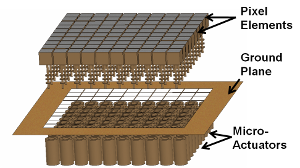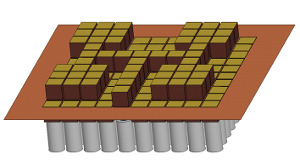Flexibility is a desirable characteristic that is being incorporated in many electrical systems, especially those related to wireless systems and radios. A reconfigurable antenna—in contrast to a traditional static antenna—can change the antennas fundamental operation. This change occurs by altering the antenna geometry, resulting in changes to the antenna’s current distribution. In the antenna context, the most obvious justification for reconfigurability is to consolidate the functionality provided by multiple antennas into a single reconfigurable antenna. This reduces space and even cost in some cases. But reconfigurability opens up other possibilities as well. In a dynamic environment such as a cell phone, a reconfigurable antenna could retune itself as interactions with other objects—such as a hand or a human head—might degrade its performance. In general, reconfigurable antennas can modify their frequency, polarization, or pattern distribution characteristics.
My research in reconfigurable antennas focuses on finding novel ways to reconfigure antennas, creating new functionalities, and improving the current state-of-the-art in design. New technologies (e.g. MEMS, Memristors, PZTs) are being developed every day, and some of my research focuses on developing platforms which nicely incorporate the technology to allow reconfigurability at the antenna level. An interesting antenna concept is shown in the figures, where a patch antenna might be reconfigured by actuating pixels in the up/down positions. I have not only conceptualize reconfigurable antenna structures, but I have integrated fully reconfigurable antennas using MEMS switches along with their necessary bias networks. The final integration is an important step towards development, and I have proposed some interesting bias line prototyping techniques using resistive ink. I am also investigating the application of reconfigurable antennas towards new systems such as software and cognitive radios. More information on that research is divulged in the Cognitive and Software Radios page.
Related Publications
- Recent developments toward reconfigurable mmWave apertures and components using vanadium dioxide RF switches
J. M. Kovitz and K. W. Allen, “Recent developments toward reconfigurable mmWave apertures and components using vanadium dioxide RF switches,” 19th IEEE Wireless and Microwave Technology Conference, Sand Key, FL, 2018.
- Enhancing Rejection in Cognitive Radio Filtennas using a Reconfigurable Filter+Antenna Approach
J. M. Kovitz and Y. Rahmat-Samii, “Enhancing Rejection in Cognitive Radio Filtennas using a Reconfigurable Filter+Antenna Approach,” in Proceedings of the IEEE Antennas and Propagation International Symposium, Fajardo, Puerto Rico, June 2016.
- Design and Implementation of Broadband MEMS RHCP/LHCP Reconfigurable Arrays Using Rotated E-Shaped Patch Elements
J.M. Kovitz, H. Rajagopalan and Y. Rahmat-Samii, “Design and Implementation of Broadband MEMS RHCP/LHCP Reconfigurable Arrays Using Rotated E-Shaped Patch Elements,” IEEE Transactions on Antennas and Propagation, vol. 63, no. 6, pp. 2497 – 2507, June 2015.
- MEMS Reconfigurable Optimized E-Shaped Patch Antenna Design for Cognitive Radio
H. Rajagopalan, and J. M. Kovitz, and Y. Rahmat-Samii, “MEMS Reconfigurable Optimized E-Shaped Patch Antenna Design for Cognitive Radio,” IEEE Transactions on Antennas and Propagation, vol. 62, no. 3, pp. 1056-1064, March 2014.
- Practical and Cost-Effective Bias Line Implementations for Reconfigurable Antennas
J. M. Kovitz, H. Rajagopalan, and Y. Rahmat-Samii, “Practical and Cost-Effective Bias Line Implementations for Reconfigurable Antennas,” IEEE Antennas and Wireless Propagation Letters, vol. 11, pp. 1552-1555, December 2012.
- Frequency Reconfigurable E-shape Patch Antenna using Nature Inspired Optimization
H. Rajagopalan, J. M. Kovitz, and Y. Rahmat-Samii. “Frequency Reconfigurable E-shape Patch Antenna using Nature Inspired Optimization,” in Proceedings of the IEEE Antennas and Propagation International Symposium, Chicago, IL, United States, July 2012.
- A Novel Optimized Broadband Reconfigurable RHCP/LHCP E-shaped Patch Antenna
J. M. Kovitz, H. Rajagopalan, and Y. Rahmat-Samii, “A Novel Optimized Broadband Reconfigurable RHCP/LHCP E-shaped Patch Antenna,” in Proceedings of the IEEE Antenna and Propagation Society International Symposium, Chicago, IL, July 2012.
- Micro-actuated pixel patch antenna design using particle swarm optimization
J. M. Kovitz and Y. Rahmat-Samii, “Micro-actuated pixel patch antenna design using particle swarm optimization,” in Proceedings of the IEEE Antenna and Propagation Society International Symposium, pp. 2415-2418, July 2011.


